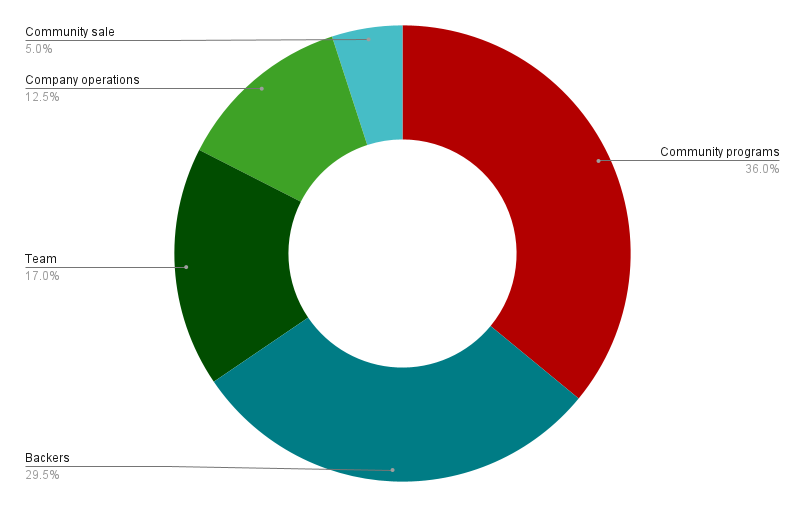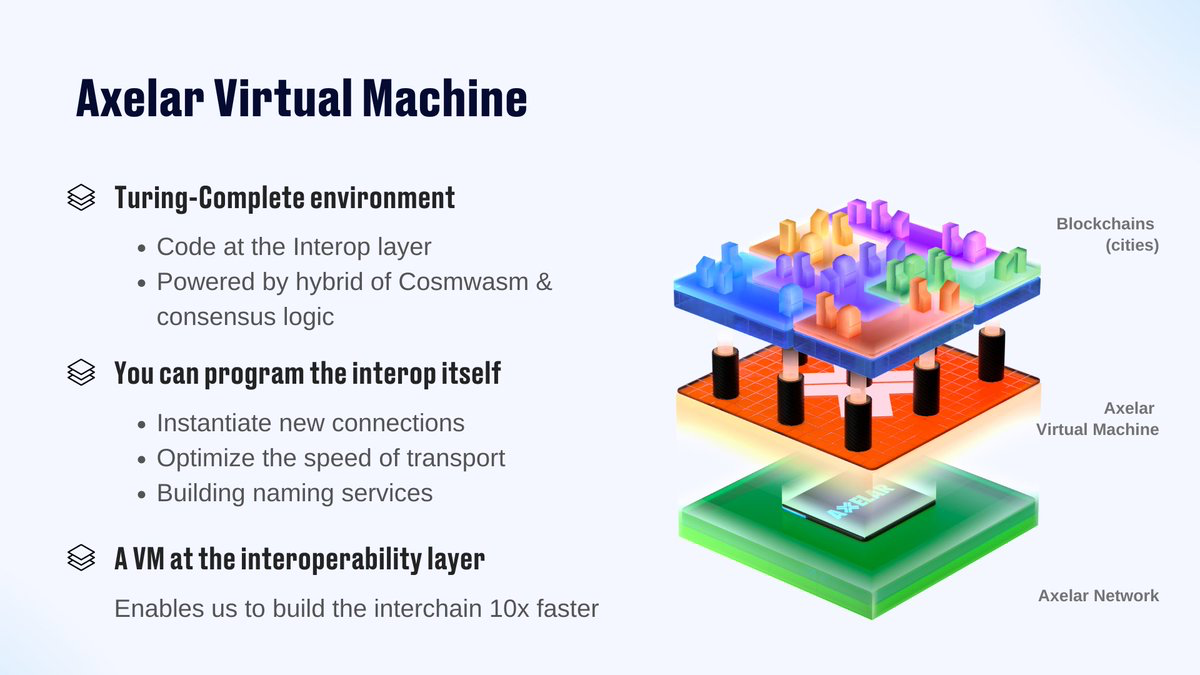Axelar: "A cross-chain future is inevitable"

Should assets be brought to computing systems, or computing systems should be brought to assets”? The answer to this question serves as the foundation for the two multi-chain components in current crypto: bridges and cross-chain messaging.
Up until now, cross-chain cryptocurrency efforts have mainly concentrated on sending a particular message structure: tokens. However, with numerous speculative developments taking place in this field, cross-chain messaging communication has the long-term potential to enable chains to exchange any kind of data.
To give readers a comprehensive view on this topic, Coin98 Insights talked with Jason Ma, Business Development Director of Axelar - a prominent cross-chain messaging protocol in the industry.
The Spotlight is a Coin98 Insights exclusive interview series with industry builders on hot market topics
A common language of the blockchain world
- Greetings, Jason. Could you explain why cross-chain messaging protocols are starting to attract attention?
Jason: Firstly, I would like to clarify the difference between cross-chain messaging and bridging, because the common misconception is that people think anything that’s related to cross-chain messaging is bridge. However, they are quite different.
Let me explain. Bridging (or bridge) is really only about asset transfers from one chain to another. Most of the time, it evolves locking an asset on the source chain and minting a wrapped version of that asset on the destination chain.
Meanwhile, cross-chain messaging is the next generation of interoperability. Cross-chain messaging allows you to pass any arbitrary payload across chains, oftentimes in a single click. This means you can build these very natively cross-chain projects right from the get-go, and it could be anything from swap to cross-chain lending, marketplace, and yield aggregation.
Basically, everything you’re having today on a single blockchain, you’re able to create a cross-chain version of that, and more.
- Very interesting. As a builder in an ecosystem where scaling is a priority, we need more chains. But from the user's point of view, it seems impossible to interact with all of these chains. So how does cross-chain messaging help to solve this problem?
Jason: Most users don’t really care what blockchain an application is running through. However, the fact everyone is very chain-focused stems from a lack of interoperability.
If you think about the Internet today, when you go to a website, do you really care about which server it’s getting routed through? You just have a more direct relationship with the website or the application, right? And you just wanna be able to do what you wanna do. And we really think blockchain is just the same.
So when you have cross-chain messaging and you’re able to build these one-click applications, people will then become chain agnostic in the future.
Another important and valued proposition is about unifying liquidity. When we think about even a year ago, there were 10 major blockchains but now even 12 months later, we’re seeing more and more change, whether it’s Layer 1, Layer 2, or sidechains. And all of them have strengths and weaknesses. So I think most people would agree at this point there’s gonna be more chains and further for intimation going forward, but it’s gonna be less liquidity and a lot more fragmentation.

But with cross-chain messaging, you’re able to compose with existing liquidity pools, on these different protocols on different chains so that actually creates a lot more efficient than what you would have.
- Is this what motivated the birth of Axelar?
Jason: The founding team of Algorand included our two co-founders, Sergey and Yorgos. The only prominent blockchains at the time were Ethereum, Ripple, and one or two others; Algorand's task was to create a blockchain that was more effective. A number of MIT professors and students were on the project team.
However, as Sergey and Yorgos developed Algorand, they soon observed a trend: a growing number of organizations would be attempting to create various effective blockchains.
The real problem is how to make these blockchains communicate and interact with each other?
That's why Axelar was born.
The biggest difference between Axelar and other solutions like Wormhole or LayerZero is that the protocol's architecture is very decentralized. Our philosophy is to build a decentralized and permissionless infrastructure because if we have a thriving blockchain ecosystem but the cross-chain architecture is centralized, it goes against the point of crypto and Web 3.
- You're talking about the architecture of Axelar. Currently, other cross-chain messaging protocols, such as LayerZero and IBC, use various security models (trust assumptions). So why did Axelar choose its current model?
Jason: That’s a very good question. Axelar itself is a PoS blockchain built using Cosmos SDK, so it’s very similar to other Cosmos app chains, but the security model that Axelar uses is Proof-of-Stake security. And the reason we built it like that is because Proof-of-Stake blockchains have been around for quite some time, and their security assumptions are well-documented and well-studied. They have all been battle-tested. This is quite in contrast to many other cross-chain messaging solutions where they are either built on centralized multisigs or use a permissioned set of validators.
And you mid mention IBC. A lot of people think Axelar is competitive to IBC, and our position on that is Axelar is actually very complementary to IBC because Axelar is built using Cosmos, and we’re actually able to connect to other Cosmos chains via IBC today.
The problem with IBC is, it’s unfortunately not compatible with EVM and some other chains. And we really see Axelar as an extension to IBC, where we’re able to communicate EVM chains with IBC chains as well as Move and Rust-based chains.

Axelar's tokenomics. Image: Figment
- Talking about competition, what do you think of Axelar’s competitors?
Jason: Our perspective is that cross-chain messaging will grow very fast. The overall market is gonna grow tremendously fast, so it’s definitely not a zero-sum game. There are gonna be may cross-chain messaging players and we can all grow together and do well, because it’s an essential part of Web3 ecosystem.
We encourage everyone to try to build decentralized cross-chain infrastructure because of the security risk that the centralized architecture poses, which could damage the entire sector.
For example, when a bridge is hacked, because an average user doesn’t understand the nuances and the design differences, they would think “Oh there’s another cross-chain protocol gets hacked, this stuff must not be safe.” And this sets the whole industry back.
Goodbye, bridges?
- We can see that bridges are vulnerable to attacks. So, how do solutions for cross-chain messaging help solve this problem?
Jason: Like I said, traditional bridges often lock assets on the source chain and then mint a wrapped version of that. So a hack happens when someone exploits a smart contract and be able to take away the original assets on the source chain and then the wrapped asset loses its value. With cross-chain messaging, you’re able to build protocols where instead of moving assets, you can just send a message. This makes things a lot safer.
Let’s take a look at Squid Router, a cross-chain liquidity router built on top of Axelar. Squid works a bit quite differently than traditional bridges: It allows you to swap any native asset on any chain by composing liquidity on DEX.
An example, if you want to go from MATIC on Polygon to AVAX on Avalanche, Squid allows it to happen with a single click:
- MATIC is swapped to USDC through a DEX on the Polygon side.
- The USDC then gets swapped to axlUSDC on a stableswap pool.
- Then axlUSDC gets bridged through Avalanche side, where it gets swapped back to USDC again and gets routed through a DEX to be swapped into AVAX.

How Axelar Virtual Machine works. Image: Axelar
This all happens with a simple click from the user’s side. And in the back end, this is taking between a minute to a couple of minutes based on the finality of the source chain. But the most important thing here is there are no real assets involved.
The only place where there could be a security risk for the users is when the axlUSDC is bridged from Polygon to Avalanche. Because after it’s done being bridged, it gets swapped immediately for native AVAX so there are no locked assets for the users.
Hence, the chance of something going wrong during that one few minutes of bridging is slimmer than someone’s always holding wrapped asset, which the original asset being locked on the source chain.
Read more: Solana: 'We want to prove Samsung, Google should integrate web3 into their phones'
- Compared to bridges, cross-chain messaging has many great advantages. Do you think bridges will be completely replaced? Or will it be built on top of a cross-chain messaging protocol like Squid Router?
Jason: I think in the future, traditional bridges with wrapped assets will play a lesser role, due to them not being as efficient as what we can achieve with cross-chain messaging. But there’s still a purpose for them.
There are new ecosystems where there are no native assets, so there has to be a traditional token bridge where someone is able to have wrapped assets and keep them in those ecosystems. Otherwise, these emerging blockchain ecosystems wouldn’t have any assets at all. I’d say most people would still want to have assets in some of these emerging ecosystems.
As for more mature blockchain ecosystems, people won’t have to bridge anymore. People would be able to use cross-chain messaging to just compose with existing liquidity and only use native assets. This is a lot safer, more elegant, and better solution for end-users.
Does the future belong to multi-chain or cross-chain?
- Let’s talk a bit more about Axelar, project was launched about a year ago but has achieved some impressive results. Can you explain the reasons for this?
Jason: How we measure our success is in three different ways.
First of all, when looking at cross-chain providers, most people look at volumes. Today, Axelar has processed over 1.85 billion USD volumes which is one of the highest of any traditional asset bridges. Last May, when cross-chain providers on Cosmos did a community vote, Axelar was chosen for our decentralized architecture. Since then, a lot of volumes have come from transfers between Cosmos and EVM.
The second main metric we look at, which was not appropriately appreciated, is the number of projects being built on top of Axelar using our Message Passing. This only went live around Q3 of last year and since then we’ve had like 200-300 projects built on Axelar with all kinds of use cases.
When I said this metric was not fully appreciated yet is because building cross-chain projects natively is quite a new concept, and a lot of these projects have been busily building in the last few quarters. And some of them have finally hit Mainnet and our people are now able to truly experience these natively cross-chain projects.
You’re obviously not going to see volumes from these projects when they’re building. But as they start going live and ramping up, we believe that in the upcoming quarters, the number of cross-chain transactions and cross-chain volumes will increase exponentially.
To sum it up, it really comes down to Axelar’s unique value proposition: We are decentralized. Our architecture is quite unique in that all blockchains built on Axelar connect to each other rather than pairwise connection.
And lastly, with our recent launching of Axelar Virtual Machine, now the network is fully programmable, and people are able to build and deploy cross-chain projects right on Axelar chain.

- Is Cross-chain messaging vulnerable to attacks? Specifically, what measures is Axelar taking to prevent malicious actors from sending fraudulent messages?
Jason: To be able to attack Axelar with a fraudulent message, a hacker has to control 60% of the voting power of the validators in order to pass a fake message. Because of this, we've put in place different safety measures, like setting a rate limit, which is like a "circuit breaker" in traditional financial services. The rate limit is set at 5 million USDC per day on our gateway contract. So, if we were hacked because of a flaw in our network, this is the most money that could be moved in a day.
We’ve also implemented validators key rotation, where we regularly rotate the keys of validators to prevent someone to attack the network and further decentralize the network by adding more validators. Moreover, Axelar is working on interchange security, with the idea that in Cosmos, you’re able to borrow validators from other chains to improve the security of a single chain.
So rather than counting only the TVL of your own chain, when you borrow validators from other chains, the collected TVL of multiple chains could be used to strengthen the economic security of your own chain.
The other thing Axear is unlike other traditional bridges. Our goal is not maximizing TVL and locking in tons of assets. We don’t secure billions of dollars like other bridges so we won’t fall prey to attackers.
Finally, there’s a kind of economic attack by buying AXL tokens, but it’s also hard to implement. Our TVL is greater than Axelar’s fully diluted market capitalization. By buying up a ton of Axelar, they would drive up the value of the Axelar token. And at the same time, there’s not enough token supply in circulation for them to be able to buy up all of the Axelar tokens for them to broaden the validators.
For all of these reasons, I am confident that Axelar is the safest in design and most meticulous in implementing security measures, in addition to auditing and bug bounty.
- Vitalik Buterin said he believes in a multi-chain future rather than a cross-chain one. As a builder of a cross-chain protocol, perhaps you might want to differ?
Jason: You’re giving me a hard question that I have to give a different opinion. But I have to say Vitalik said this over a year ago when we didn’t have the kind of cross-chain messaging technology we have today. So I think it came from a very different context and time.
Looking at where we are today, it doesn’t look like a Layer2-focused world, right? We have emerging ecosystems like Cosmos that focus in appchains, we have various sidechain ecosystems such as Avalanche Subnet, Polygon Supernet. We even have Layer2 ecosystem like Optimism with superchain such as Base, which I think is very close to appchains on Cosmos and other ecosystems.
So I think horizontal scaling and having more and more appchain is inevitable.
So to say that the world will be multi-chained and these chains don’t fully compose with each other and be in trouble with each other is something that’s very hard to happen.
As a result, I think a cross-chain future is something inevitable.